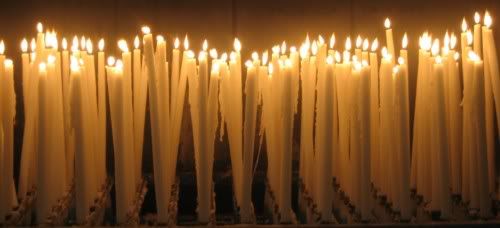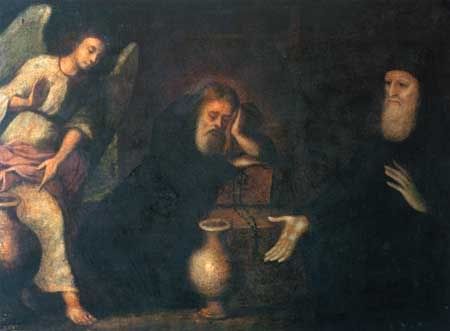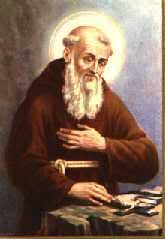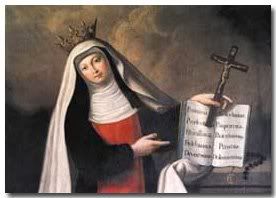Saint Joseph of Leonissa (1556-1612) was born in Naples to a relatively poor family. From an early age, Joseph demonstrated a deep faith, erecting alters and praying to the Lord, rather than playing with siblings and peers. Oftentimes, he would encourage his young friends to pray with him, with great success. While a marriage had been arranged for him, following a serious illness during which he lost consciousness, Joseph joined the Franciscan Order. He was known for great abstinence. Referring to himself as “Brother Ass,” he is reported to have instructed his body, “there is no need to feed thee as a noble horse would be fed: thou must be content to be a poor ass.” Following fasting for an entire year, Saint Joseph traveled to Constantinople, to minister to the many Christian slaves being help in captivity there. Armed with only a Crucifix and his deep faith, he attracted many to Christianity by witness of his seemingly “comfortable poverty” and willingness to give up all he had for the Lord. Eventually, his daily preaching landed him in prison, where he sought audience with the sultan. Given permission to speak to the sultan, Saint Joseph pleaded for religious tolerance and freedom, and attempted to convert the leader. Instead, he was sentenced to death. Records indicate that he was hung by hooks through his right hand and right foot, over a smoky fire, in the center of town. Following three days of this torture, he was miraculously rescued by an angel, and returned to Italy to minister to the poor. There he resumed his vocation of wandering preacher to small villages throughout the country. With an eye of ministering to the poor, sick, and imprisoned, he helped establish hospitals, homeless shelters, and food banks. With his Crucifix in hand, he would wade into gang fights and brawls, praying, and preaching peace and good sense. Saint Joseph died on Februay 4, 1612.
 Saint Joan of Valois (1464-1505) was born into nobility in France. The second daughter of Louis XI, Joan was not blessed with the physical beauty and health of her royal family. Rather, she was blessed in other ways, including a deep piety and faith in the Lord and the Blessed Mother, and a conviction to follow the will of God. Joan, who by reports was hunchbacked, and subsequent to serious skin infections in her youth, quite pockmarked, was a difficult daughter for the king to marry off. Despite her daily suffering and disabilities, Joan remained cheerful and penitent, expressing her desire to join the Third Order of Saint Francis. Her father, however, forbade her to enter a religious community, having secured a husband for her. Joan was forced to marry the Duke of Orleans, who shortly thereafter became King Louis XII, and immediately divorced Joan, citing that he had been compelled, under fear of death, to marry her. Joan’s simple response was, “If so it is to be, praised be the Lord.”
Saint Joan of Valois (1464-1505) was born into nobility in France. The second daughter of Louis XI, Joan was not blessed with the physical beauty and health of her royal family. Rather, she was blessed in other ways, including a deep piety and faith in the Lord and the Blessed Mother, and a conviction to follow the will of God. Joan, who by reports was hunchbacked, and subsequent to serious skin infections in her youth, quite pockmarked, was a difficult daughter for the king to marry off. Despite her daily suffering and disabilities, Joan remained cheerful and penitent, expressing her desire to join the Third Order of Saint Francis. Her father, however, forbade her to enter a religious community, having secured a husband for her. Joan was forced to marry the Duke of Orleans, who shortly thereafter became King Louis XII, and immediately divorced Joan, citing that he had been compelled, under fear of death, to marry her. Joan’s simple response was, “If so it is to be, praised be the Lord.”Joan left the palace, and began a devout and solitary life of prayer, She formed a contemplative society for women—the Order of the Annonciades (Annunciation)—which she served as abottess of. Its members were to devote themselves to prayer and penance, and to cultivate in all ways the virtues of Our Lady. Joan, through her own acceptance of God’s will, drew parallels between the Annunciation of Mary (“I am the handmaid of the Lord. Let it be done to me according to Thy Word.”) and her own experience, instructing her charges with a firm hand. Throughout her difficult life, Joan maintained a gentle spirit of love and kindness, and above all else, the acceptance of the Will of God in her life. Joan of France was buried in the gray, scarlet and white habit of her order, but also with the royal crown. Many miracles, especially cures, are now attributed to her intercession at her tomb.
Saint Theophilus the Penitent (born unknown, died 538), also known as Saint Theophilus of Adana, was born in Turkey and eventually became an Orthodox cleric and archdeacon of Adana. Little is known about the events of his life, although legend remains regarding the role of repentance and penance in the lives of Christians. Legend recounts that Theophilus, then an archdeacon, was offered the position of bishop, but declined out of false humility. The bishop subsequently appointed deposed Theophilus’ archdeaconship. Filled with rage, pride, jealousy, and human ambition, Theophilus is said to have made a deal with the Devil to acquire the bishopric, as well as a great deal of wealth. However, upon awakening from sleep the next morning, Theophilus was filled with regret and fear for his soul. Having renounced Christ by signing a pact with the Devil, Theophilus began a rigorous fast, praying for forty days to the Blessed Virgin for forgiveness and assistance. Per legend, on the fortieth day, Mary, Mother of God, appeared to Theophilus, verbally chastising him, but granting assistance. Upon awaking again from sleep, the pact he had signed with the Devil, lay upon his chest. He took the contract to the bishop, confessing his sins. The bishop destroyed the contract with fire. Theophilus subsequently made a public confession, and spent the remainder of his life in penance and repentance, distributing his acquired wealth to the poor, and praying for salvation.
While the legend of Saint Theophilus is quite fantastical (as are many of the miracles associated with the early Saints of the Church), the lesson is quite clear, and when reflected upon, suggests why this legend persists in the faith even today. Theophilus was blinded by his anger, jealousy, and pride, and in doing so, turned away from the teachings of Christ. It isn’t until the intercession of the Blessed Mother that he realizes what has been lost, and begs for forgiveness with all his heart. Of course, our Lord, again proving His infinite love and mercy for us, welcomes him back without question.
Taken together, these three saints give us much to consider. How often are we dissatisfied with our lot in life? Whether, like Joan, it be due to our appearance or physical abilities, or like Theophilus, based upon our status, wealth, or position? How frequently do we turn from the life that the Lord wants us to live to pursue the peripheral and temporary rewards of the human world? How wonderful would it be to give up all we had, like Saint Joseph, and instead concentrate on that which lasts forever—our relationship with the Lord? How might we take steps in that direction? What can we do today to put the Lord first in our life?
Day 35 of 365
Prayer Intentions: Repentance, Penance, Courage, Acceptance of God’s Plans for us.
Requested Intentions: Priests and leaders of the Church (L); The rest and repose of a dearly departed friend (J); Reconciliation of struggling marriages (A); Reconciliation and healing in personal relationships (N).
Special Intentions: Novena to Our Lady of Prompt Succor, for those who are struggling in the face of personal trials and tribulations, unemployment and financial stress, natural disasters (including the poor of Haiti), poverty, war, and exploitation. May Our Lady of Prompt Succor hasten to help us!











0 comments:
Post a Comment
Thanks for leaving a comment. If you wish to submit a prayer request, however, please do so above, using the "Contact" tab.